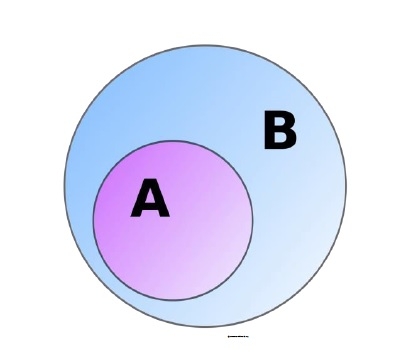
 Data Structure
Data Structure Networking
Networking RDBMS
RDBMS Operating System
Operating System Java
Java MS Excel
MS Excel iOS
iOS HTML
HTML CSS
CSS Android
Android Python
Python C Programming
C Programming C++
C++ C#
C# MongoDB
MongoDB MySQL
MySQL Javascript
Javascript PHP
PHP
- Selected Reading
- UPSC IAS Exams Notes
- Developer's Best Practices
- Questions and Answers
- Effective Resume Writing
- HR Interview Questions
- Computer Glossary
- Who is Who
issubset() function in Python
In this article, we will learn the implementation and usage of issubset() function available in the Python Standard Library.
The issubset() method returns boolean True when all elements of a set are present in another set (passed as an argument) otherwise, it returns boolean False.
In the figure given below B is a subset of A. In case A & B are identical sets mean that A is a proper subset of B. This means both sets contain the same elements in them.

Syntax
<set 1>.issubset(<set 2>)
Return value
boolean True/False
Now let’s look at an illustration to understand the concept.
Example
A = {'t','u','t','o','r','i','a','l'}
B = {'t','u','t'}
C = {'p','o','i','n','t'}
print(B.issubset(A))
print(B.issubset(C))
A=set(str(A)+str(C))
print(C.issubset(A))
Output
True False True
Explanation
Here a check is made that all elements of B are contained in A which evaluates to be true. Similarly for the next statement output is produced.
Now we concatenated to sets to make it a subset forcefully by using typecasting as seen in the next statement.
Now let’s see what happens if we specify another type of iterable than set and pass it as an argument.
Example
A = ['t','u','t','o','r','i','a','l']
B = {'t','u','t'}
C = ('p','o','i','n','t')
D = {'p','o','i','n','t'}
print(B.issubset(A))
print(B.issubset(C))
A=set(str(A)+str(C))
print(D.issubset(A))
Output
True False True
Explanation
Here we passed tuple, string and list iterables to the issubset() function. These types are implicitly converted to set type so as to get the desired output.
We must also observe that the argument outside the function must always of type <set> so that the interpreter must know that comparison is between two sets and not any other type.
Conclusion
In this article, we learned how to use isubset() function in Python and what all types of arguments are allowed to be compared with the help of this function.
